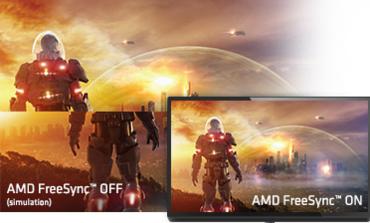Nvidia G-Sync vs AMD FreeSync
What you should know about these technologies, the technology is very similar, only developed by different video card giants. G-Sync – works with video cards made by Nvidia and, of course, this technology only works with video cards that use Nvidia chips.
FreeSync – works with video cards made with AMD chips.
The resources of computers and computer monitors are used to display content, very often it is dynamic content or high frame rate in video games. The computer graphics card processes and creates frames and sends them to the monitor for display. What is needed here is for the created frames to be processed by the monitor and displayed without delay.
Technologies (AMD FreeSync, Nvidia G-Sync) provide full software synchronization between the graphics card and the monitor. For these technologies to work, some conditions must be met.
If you have an AMD video card, the monitor must support AMD FreeSync. If your video card is Nvidia, the monitor must support Nvidia G-Sync.
Special software needs to be installed.
Video cards must support these technologies.
Monitor frequency
There are monitors that support 60 Hz, there are monitors that support 120 Hz or 144 Hz, which means that in one second the monitor can show, for example, 60 frames. But a video card doesn’t necessarily deliver that number of frames, it can deliver 30 or 65 frames per second. This can be noticed by gamers who control the frame rate of the game. With monitors without FreeSync or G-Sync support, the solution was very simple, the video card would sync with the monitor at a given frequency. If less frames were created, then some frames were duplicated, and it was not reasonable to create more frames because the monitor did not show the extra frames anyway.
How the monitor works without FreeSync and G-Sync
Now about how a digital frame is transmitted, such a frame consists of a set of cubes, which are folded into an image, video is transmitted to the monitor using a special algorithm, the monitor must receive streaming video and show frames.
But if for some reason the monitor did not have time to process and show the frame, because it is running at a stable frequency, the monitor must show the picture, even if the frame is not fully formed, but to show a blank screen is wrong, so part of the previous and new fragment of the frame is displayed, the picture may be distorted. These are natural artifacts that occur in fixed frequency devices.
How FreeSync and G-Sync work
If sync is enabled, FreeSync and G-Sync will initiate additional communication between the monitor and the graphics card. The monitor and computer will be in sync. If the monitor fails to show frames in time, the graphics card will reduce the frequency. You will not see any image artifacts, the image will always be of high quality.
Disadvantages of FreeSync vs G-Sync
Providing a floating frequency to synchronize the monitor with your graphics card is solved by both software and the preliminary implementation of special synchronization chips. The monitor displays at the frame rate that is generated by the graphics card. The disadvantage is one, it is inherent in both technologies, if you have a video card from Nvidia, then you need a monitor that supports G-Sync and vice versa.
What’s better FreeSync vs G-Sync
These technologies are very similar, each has its own nuances, but it’s like comparing an Intel and AMD processor. Yes there are differences but on the whole 99% of users don’t care.
These technologies work only with powerful video cards, it is also noted that video synchronization reduces performance by 1.5-2%. The correct operation of AMD FreeSync and Nvidia G-Sync technologies is 99% dependent on the video card. Moreover, these technologies are needed mainly in games, if you use the monitor for work, you can not pay attention to these technologies.







